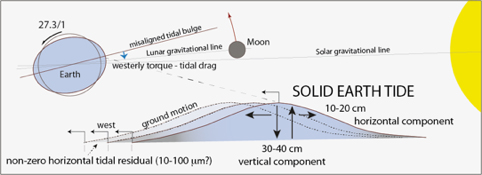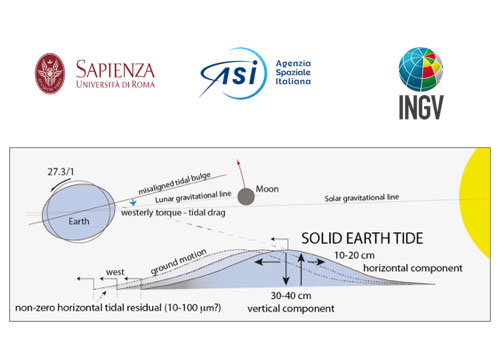Le forze di natura astronomica come le maree solide svolgono un ruolo attivo sulla tettonica delle placche: è quanto affermano i risultati di una ricerca frutto della collaborazione fra l’Università Sapienza di Roma, l’ASI e l’INGV.
Il motore della dinamica delle placche tettoniche è ancora relativamente poco chiaro. Da decenni si è pensato che la Luna e il Sole potessero contribuire alla dinamica interna della Terra, ma, nonostante vi fossero molte evidenze indirette, la loro influenza non era mai stata dimostrata in modo convincente.
Non tutti sanno che oltre alle maree liquide vi sono anche le maree solide che deformano continuamente la crosta terrestre, dislocando il suolo sia sulla verticale che sulla orizzontale di diversi decimetri. Con lo studio “Tidal modulation of plate motions” appena pubblicato su Earth Science Reviews, gli scienziati dell’Università Sapienza di Roma, dell’Agenzia Spaziale Italiana (ASI) e dell’Istituto Nazionale di Geofisica e Vulcanologia (INGV) hanno fatto luce sull’importanza delle maree solide, (cioè di quelle deformazioni del suolo e di tutta la crosta terrestre che avvengono durante il passaggio allo zenit dei due corpi celesti) provando il legame fra gli spostamenti delle placche tettoniche e le forze di natura astronomica come le maree, in particolare nella loro componente orizzontale.
Gli effetti periodici delle maree si verificano a intervalli di tempo molto diversi. Alcuni hanno alta frequenza, cioè avvengono con cadenza semidiurna, diurna, bisettimanale e mensile. Altri, invece sono a bassa frequenza con cadenze più lunghe: semi-annuali, annuali, 8,8 e i 18,6 anni circa, fino ad arrivare a quella della precessione degli equinozi che ha un periodo di 26.000 anni. Quelle con periodi di 8,8 e 18,6 anni, sulle quali si è focalizzato lo studio, sono dovute, rispettivamente, alla precessione del perigeo e del nodo ascendente della Luna.
Le oscillazioni ad alta frequenza sono per lo più smorzate dall’alta viscosità del guscio esterno della Terra, la litosfera, che è spessa circa 100 km e il cui movimento relativo al mantello sottostante è rimasto finora inspiegato. Inoltre, le oscillazioni ad alta frequenza si confondono con fattori climatici e stagionali dovuti a oscillazioni della pressione atmosferica e dei cicli dei fluidi nel sottosuolo e nei bacini oceanici. Da qui l’idea di ricercare oscillazioni orizzontali di bassa frequenza sulle linee di base inter-continentali, perché univocamente attribuibili alle sollecitazioni mareali.
Ciò è stato possibile grazie alla rete globale di stazioni GNSS permanenti (la sigla sta per “Global Navigation Satellite Systems”, che comprende sia il GPS americano che il sistema GALILEO europeo) attraverso la quale è possibile effettuare misure di velocità tra le placche anche tra stazioni a migliaia di chilometri di distanza.
Grazie a importanti servizi internazionali operanti da almeno 30 anni come l’International GNSS Service (IGS), cui contribuisce in modo significativo l’ASI attraverso il suo Centro di Geodesia Spaziale di Matera, le stazioni hanno accumulato serie storiche delle loro coordinate giornaliere lunghe ormai almeno 20 anni, necessarie per svolgere questo tipo di analisi.
Così Davide Zaccagnino, Francesco Vespe e Carlo Doglioni hanno effettuato l’analisi delle variazioni nel tempo della velocità di allontanamento o avvicinamento tra le placche.
Dai loro studi è emerso che la deriva secolare dei continenti, cioè delle placche litosferiche in cui è suddiviso il guscio del pianeta, è modulata da una vibrazione che oscilla alle stesse basse frequenze delle maree. E’ stata fatta una controprova per linee di base intra-placca per capire se queste oscillazioni persistessero o meno. Proprio la trascurabilità riscontrata su linee di base intra-placca ha confermato che queste forze astronomiche giocano un ruolo decisivo nel descrivere i moti della deriva dei continenti che, quindi, lentamente si muovono verso ‘ovest’ grazie alla spinta orizzontale delle maree solide rispetto al mantello sottostante, lungo un flusso ondulato descritto dal cosiddetto equatore tettonico che fa un angolo di circa 30° con l’equatore geografico.

Astronomical forces such as solid Earth’s tides play an active role on plate tectonics: this is the results of a research conducted by the Sapienza University of Rome, the Italian Space Agency (ASI) and the Istituto Nazionale di Geofisica e Vulcanologia (INGV).
For decades it has been thought that the Moon and the Sun could contribute to the dynamics of the Earth. However, despite a lot of indirect evidence, their influence had never been convincingly demonstrated.
Few people are aware that tides are affecting not only the oceans, but also the solid Earth and its crust. With the study “Tidal modulation of plate motions”, just published in Earth-Science Reviews, scientists from the Sapienza University of Rome, the Italian Space Agency (ASI) and the National Institute of Geophysics and Volcanology (INGV) have shed light on the importance of solid tides, those deformations that swing up and down but also horizontally the ground and the earth’s crust of few tens of cm during the passage at the zenith of the two main celestial bodies affecting our planet, i.e., the Moon and the Sun, proving the link between the displacement of tectonic plates and the horizontal component of the Earth’s tides.
Periodic tidal effects occur at very different time intervals. Some have high frequency, that is, they occur on a semi-day, day, biweekly and monthly basis. Others, on the other hand, are low-frequency with longer cadences: semi-annual, annual, 8.8 and around 18.6 years, up to that of the precession of the equinoxes which has a period of about 26,000 years. Those with periods of 8.8 and 18.6 years, on which the study has focused, are due, respectively, to the precession of the perigee and the ascending node of the Moon.
The high-frequency oscillations are mostly buffered by the high viscosity of the Earth. Furthermore, high-frequency oscillations are often mixed with climatic and seasonal factors due to atmospheric pressure variations and fluid cycles in the subsoil and the ocean basins.
Hence the idea of looking at low-frequency horizontal oscillations because they are uniquely attributable to tidal stresses. This has been possible due to the global network of permanent GNSS stations (the acronym for Global Navigation Satellite Systems, which includes both the American GPS and the European GALILEO system), that allowed to perform speed measurements between sites at thousands of kilometers distance on different tectonic plates.
Thanks to the important international services operating for at least three decades such as the International GNSS Service (IGS), to which ASI significantly contributes through its Matera Space Geodesy Center, the stations have accumulated historical series of their daily coordinates of at least 20 years required to unravel this type of analysis. Davide Zaccagnino, Francesco Vespe and Carlo Doglioni carried out the analysis of the variations in time of the speed of lengthening or convergence among the plate pairs.
Their studies have shown that the continents drift, that is, the lithospheric plates into which the planet’s shell is divided, is modulated by vibrations that oscillate at the same low-frequency of the horizontal component of the solid Earth’s tides. A counter-test was also made for intra-plate baselines to understand whether these oscillations persisted or not.
Precisely the negligibility found on intra-plate baselines confirmed that these astronomical forces play a decisive role in describing the motion of the continents which slowly drift toward the ‘west’ thanks to the horizontal shift of the solid tides with respect to the underlying mantle, along the undulated flow of plates and so-called ‘tectonic equator’ that makes an angle of about 30° with the geographical equator.





